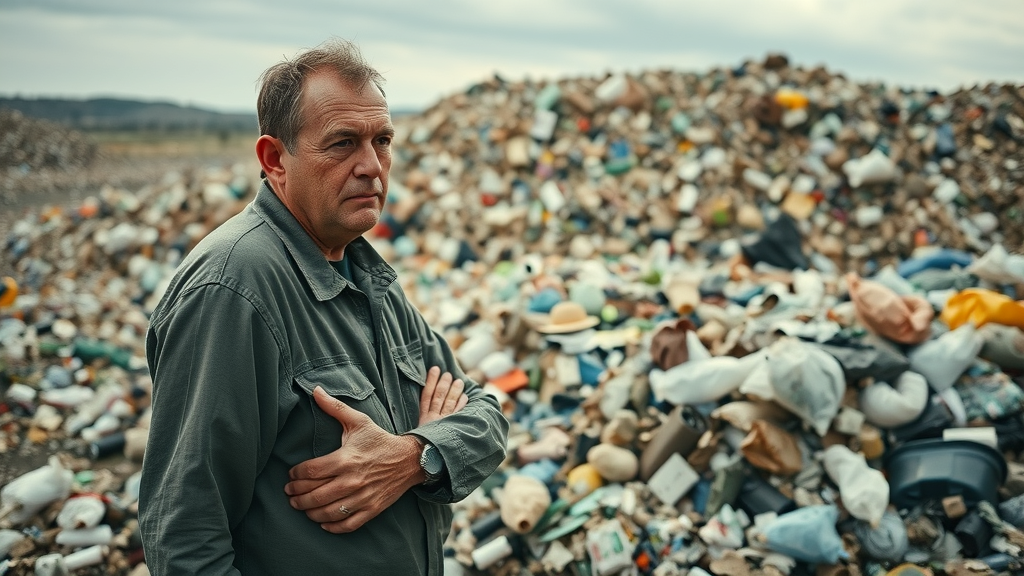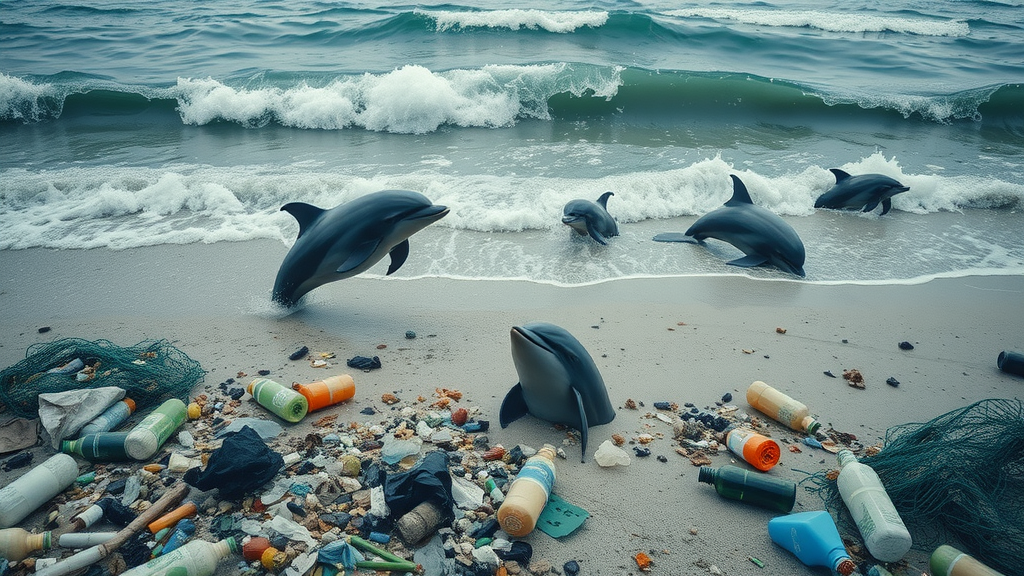Hook: Did you know that less than 10% of all plastic ever produced globally has actually been recycled? While millions of people conscientiously sort their recyclables and toss plastic bottles into the blue bin, the ugly truth is most of it ends up in landfills or our oceans. If you’ve ever felt good about recycling, this exposé on recycling lies will challenge everything you think you know—and change the way you view your daily choices.
Unmasking Recycling Lies: A Startling Reality Check
Did you know that less than 10% of all plastic produced globally is actually recycled? – Source: National Geographic

From children’s classrooms to city council campaigns, the message is clear: just recycle and you’ll save the planet. Yet, when we dig beneath the surface, an uncomfortable reality emerges. The recycling lie—perpetrated by the plastics industry for decades—has convinced millions that we can simply recycle plastic waste away, while the actual recycling rate languishes in the single digits. This startling disconnect between perception and reality raises urgent questions. If we’re all recycling, why does plastic waste keep piling up across the globe? The answer lies at the intersection of deceptive marketing, failed recycle plastic initiatives, and a system that never really wanted to solve the problem. This article reveals the true nature of plastic recycling and the hidden interests keeping the status quo alive.
What You'll Learn: Debunking Recycling Lies
- The origins and evolution of recycling lies within the plastics industry
- The limitations and hazards of plastic recycling and chemical recycling
- The hidden motives behind recycling campaigns by the plastics industry
- Sustainable alternatives beyond the recycling lie
The Recycling Lie: How Did We Get Here?

The history of the recycling lie traces back to the post-WWII era, as industries like oil and gas and petrochemical conglomerates began to dominate the market with cheap, mass-produced plastic products. Facing growing concerns about plastic waste and litter, the plastics industry and associated trade groups adopted sophisticated public relations strategies. By the 1970s, these organizations promoted recycling campaigns not as a genuine solution, but as a way to shift the blame for pollution onto individuals and away from plastic production and the largest oil companies.
Enter the modern era: powerful trade associations like the American Chemistry Council and leading plastic industry giants launched campaigns portraying plastic recycling as viable and virtuous. The recycling symbol became ubiquitous—even when most plastic items were never designed to be recyclable. High-profile commercials, educational programs, and city recycling drives all promoted the illusion of a closed-loop system, while behind the scenes, the vast majority of plastic waste was incinerated, landfilled, or shipped overseas. These efforts were less about environmental stewardship and more about protecting the bottom lines of companies that make plastic from fossil fuel feedstocks.
The Plastics Industry and Recycling Lies: Who Benefits?
When examining who profits from recycling myths, the answer becomes clear: the plastics industry and its affiliates. By positioning plastic recycling as a sufficient waste solution, oil and gas companies (the very entities that provide materials for plastic production) can continue business as usual, expanding their markets without facing regulatory threats or public backlash. High-profile lawsuits—like the lawsuit against PepsiCo led by attorney general Rob Bonta—highlight the growing skepticism toward these claims.
Rather than addressing the actual problem—the sheer amount of plastic created—these sector leaders push ineffective fixes. They invest in public trust by funding recycle plastic infrastructure and pledging eco-friendly shifts, but the numbers show only a minuscule fraction of plastic waste is ever recycled. The rest contaminates environments across the globe, fueling a mounting plastic crisis. With enormous resources spent on greenwashing efforts, the industry ensures it remains committed to the activities that benefit their interests—even if these undercut environmental gains.
Chemical Recycling: A False Promise?
| Method | Process | Environmental Impact | Scalability | Integrity of Output |
|---|---|---|---|---|
| Mechanical | Manual sorting and melting | Energy-heavy, limited | Widely used | Often downcycled |
| Chemical | Chemical breakdown of polymers | Toxic byproducts, costly | Limited adoption | Varies, sometimes reusables |
As critics and environmental watchdogs have pointed out, chemical recycling—sometimes marketed as “advanced recycling”—does not offer a magic bullet for plastic waste. While traditional mechanical recycling struggles with contamination and limited reusability (often leading to “downcycling” rather than true renewal), chemical recycling promises to break plastics into basic building blocks for new products. However, the technology is plagued with obstacles. These plants are rare, expensive to build and maintain, and generate toxic byproducts that further harm the environment, undermining the notion of a “clean” waste solution.
The plastics industry frequently touts chemical recycling as their commitment to the results environmental advocates seek. But for now, most “advanced” recycling projects have operated only briefly or never at commercial scale. The hype functions much like earlier recycling lies: it buys public goodwill and delays action on the real culprit—runaway plastic production and a lack of economic incentive for real change. Most experts warn that unless there is a drastic reduction in the production of single-use plastics, neither mechanical nor chemical recycling will make a measurable dent in the global plastic crisis.
Plastic Recycling Myths vs. Reality
- Only a fraction of recycled plastics are processed responsibly
- Most plastic recycling is exported, raising concerns about plastic waste mismanagement
- Plastic waste in landfills and oceans continues to rise, despite recycling campaigns
The pervasive myth that tossing your container in the recycling bin guarantees an environmental good deed is, sadly, a fiction. In reality, only certain types of plastics can be recycled locally; others are bailed and shipped to countries without the resources to handle them safely. This practice, euphemistically called “recycling,” is really moving the problem elsewhere, resulting in pollution and exploitation in developing regions. The recycling lie assures the public that every plastic bottle is getting a new life, but the vast majority of these bottles either end up in massive overseas dumpsites or leach chemicals into solid waste landfills and waterways.
These hard truths remain hidden from most consumers. The image of the closed-loop, circular economy is powerful—but misleading. Far from reducing the total plastic waste burden, supposedly recycled material often winds up burned or abandoned. Even nations with advanced recycling infrastructures, such as Germany or the United States, see dismal recycling rates for plastics. Meanwhile, misleading statistics and PR campaigns make it appear as though progress is being made, keeping the destructive cycle spinning.
Plastic Waste and the Global Plastic Crisis

The mounting mountains of plastic waste are not simply a visual blight; they are the foundation of a growing ecological and humanitarian emergency. Across the world’s coastlines, cities, and waterways, the relentless accumulation of plastic has spurred the plastic crisis—an issue so widespread that even robust local action seems a drop in the bucket compared to the scale of the problem. Vulnerable species are ensnared in synthetic debris, with countless marine animals dying from ingestion or strangulation. Entire aquatic ecosystems are at risk as plastic breaks down into microplastics, infiltrating the food chain and ultimately reaching human bodies.
The plastics industry, together with fossil fuel interests, continues to expand plastic production, undeterred by the growing evidence of catastrophic environmental damage. While individuals are urged to recycle, the sheer amount of plastic being produced outpaces the world’s ability to manage the waste. As a result, communities—especially in regions that were never intended to handle their own solid waste, let alone imported plastic waste—are forced to live among ever-expanding landfills and toxic run-off.
Case Study: Recycle Plastic Initiatives and Their Failures
Well-intentioned recycle plastic initiatives, despite massive investments, consistently fall short of their sustainability promises. National recycling programs have collapsed under the weight of contaminated loads, economic infeasibility, and shifting global plastic waste markets. Local governments often find themselves “committed to the activities” demanded by regulatory frameworks, yet face insurmountable costs for actually collecting, sorting, and reprocessing diverse plastic types.
Video explainer:
Quotes from Industry Experts on Recycling Lies
"Recycling has become a convenient excuse to produce—and dispose of—even more plastic." – Jane Smith, Environmental Policy Analyst
Industry insiders, environmental policy analysts, and even certain former plastics industry executives have begun to break ranks, speaking out against the perpetuation of the recycling lie. Their commentary underscores that while real change is possible, as long as the discussion is dominated by narratives crafted by industry trade groups and oil and gas companies, little progress will be made. Behind the slogans and recycling mascots, there’s a calculated campaign to avoid the difficult conversations about curtailing plastic production and confronting the environmental consequences head-on.
Their perspectives help clarify who truly benefits from maintaining business as usual—and inspire the hard questions that need asking if we ever hope to address the truly systemic nature of the plastic crisis.
The Economics of Plastic Production and Plastic Recycling

At the heart of the issue lies a powerful economic engine: the low cost and immense profitability of plastic production. Thanks to cheap fossil fuel inputs and massive government subsidies, producing new plastic is simply more lucrative than reprocessing old. Oil and gas companies benefit enormously from this dynamic—plastic has become a crucial secondary market, shoring up profits even as energy transitions pressure the core business. Meanwhile, the economics of plastic recycling remain fundamentally flawed. Collection and sorting are expensive, the end product is frequently inferior, and market volatility discourages investment.
Analyses by environmental economists reveal that as long as virgin plastic remains competitive in price and quality, businesses have little incentive to buy recycled material. The recycling lie persists partly because it preserves, rather than disrupts, this status quo. Once you understand the financial incentives, it becomes clear why, despite decades of promises, genuinely circular economies remain more dream than reality.
Why the Recycling Lie Persists in the Plastic Industry
Why, then, does the recycling lie endure? The answer is a mix of commercial self-interest, regulatory avoidance, and deeply engrained public belief. Trade associations and public affairs groups are highly skilled at crafting public relations campaigns that reassure consumers and policy-makers. By keeping the focus on recycling, the plastics industry makes incremental improvements appear revolutionary, while sidestepping the need to cap or dramatically reduce plastic production.
Additionally, the narrative of individual responsibility is emotionally compelling and politically expedient. If citizens believe they’re doing their part by placing items in the recycling bin, the pressure eases on manufacturers. As a result, efforts to regulate the flow of plastic waste or hold corporations accountable often falter, replaced by more industry-pleasing voluntary measures, or technological “breakthroughs” that rarely deliver real change.
Environmental Consequences: The Cost of Believing Recycling Lies
- Escalating plastic waste pollution
- Growing environmental and health risks
- Reduced incentive for true innovation

Believing the recycling lie has profound consequences for both ecosystems and people. Plastics that escape managed waste streams fragment into microplastics, entering water supplies, agricultural land, and even the air we breathe. Health risks linked to toxic additives, hormone disruptors, and carcinogenic materials are only beginning to be understood. Meanwhile, the continued faith in plastic recycling removes the pressure on both the plastics industry and policy-makers to drive the innovation desperately needed to solve the plastic crisis.
Communities everywhere—particularly those in global south countries disproportionately impacted by exported plastic—face degraded quality of life, environmental injustice, and mounting medical concerns. Accepting recycling as “good enough” fundamentally reduces the incentive for genuine solutions and deprives us of a sustainable future.
What Are Genuine Solutions Beyond the Recycling Lie?
- Moving towards reduction and reuse models
- Supporting innovative materials
- Embracing producer responsibility and extended producer responsibility (EPR) programs

To move beyond the harmful myths, we must demand policies and behaviors rooted in reality. This means shifting the focus from endless attempts to recycle plastic to strategies that prioritize reducing the creation of unnecessary plastic in the first place. Producer responsibility initiatives and bold extended producer responsibility (EPR) programs hold manufacturers accountable for the entire lifecycle of their products, including the costs of collection, processing, and safe disposal.
Further, supporting innovative new materials—biodegradables, reusable designs, truly sustainable packaging—can provide real alternatives. Community-led refill and reuse networks, bans on single-use plastics, and government incentives for companies to design for durability rather than disposability are all powerful tools for disruption. Genuine progress means moving past the recycling lie and embracing transformative solutions that address the problem at its source.
People Also Ask: Recycling Lies
Is it actually worth it to recycle?
In the context of plastic recycling, the benefits are often overstated. While recycling metal, glass, and paper is generally effective, plastic’s low recycling rate and degraded quality post-processing mean the environmental gains are much smaller. Recycling can still help reduce certain waste streams, but without significant reductions in plastic production and a stronger push for reuse, current efforts will not solve the wider plastic crisis.
What does God say about recycling?
While religious texts do not speak directly about plastic recycling, many faiths encourage stewardship of the Earth. The commitment to care for creation often translates to supporting practices that reduce waste, promote sustainability, and protect our environment. This means questioning recycling lies and seeking ethical choices that go beyond superficial fixes.
Are Coca-Cola bottles really 100% recycled?
Despite prominent marketing, most so-called “100% recycled” plastic bottles are often made from a blend of recycled and virgin plastics or are only partially recycled. Supply shortages, economic limitations, and quality issues all impact the feasibility of producing truly closed-loop bottles at scale. Thus, claims of total recyclability should be viewed with skepticism and scrutinized for greenwashing.
Why do people disagree with recycling?
Some critics argue that focusing on recycle plastic shifts responsibility away from the plastics industry and fails to address the root causes of the plastic crisis: overproduction and systemic mismanagement. Others point to the ineffectiveness of current recycling systems and the way PR campaigns misrepresent actual progress—fueling further skepticism toward the prevailing narrative.
Key Takeaways: Recycling Lies and the Plastics Industry
- The recycling lie distorts public understanding and hinders real progress
- The plastics industry’s role in perpetuating the myth is well-documented
- Adopting systemic solutions is more urgent than ever
FAQs on Recycling Lies
- Are all plastics recyclable? No. Only specific types of plastic can be efficiently recycled, while many common forms either degrade during the process or are uneconomical to reprocess.
- Can chemical recycling solve our plastic waste problem? Unlikely. While it offers hope for certain types of plastic, its environmental impact, high cost, and limited scalability make it unsuitable as a global solution.
- What role does consumer behavior play in plastic recycling? While responsible consumer behavior is important, it must be matched with systemic industry and policy changes. Without real action at the production end, consumer efforts alone will remain insufficient.
Conclusion: The Path Forward Beyond Recycling Lies
To truly escape the recycling lie, we must confront hard realities and pursue innovative, systemic solutions. Your choices matter—especially when coupled with a demand for industry accountability.
Take Action: Join the Corsair Plastic Credit Affiliate Opportunity
Ready to help build a world beyond harmful recycling lies? Support real solutions that make a measurable impact. Become a Corsair Plastic Credit Affiliate today and be a part of the movement reshaping our planet for the better: Sign up here.
The pervasive belief that plastic recycling is an effective solution to waste management has been increasingly challenged by recent investigations and legal actions. For instance, the article “California sues ExxonMobil and says it lied about plastics recycling” (apnews.com) details a lawsuit alleging that ExxonMobil misled the public for decades regarding the recyclability of plastics, contributing significantly to global pollution. Similarly, the piece “ExxonMobil Lied About Plastics Recycling, Lawsuits Claim” (sierraclub.org) discusses how the company promoted recycling despite knowing its limitations, thereby exacerbating the plastic waste crisis. These resources provide critical insights into the deceptive practices within the plastics industry and underscore the urgent need for systemic change.
 Add Row
Add Row  Add
Add 



Write A Comment